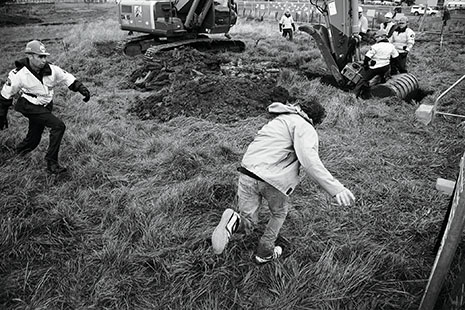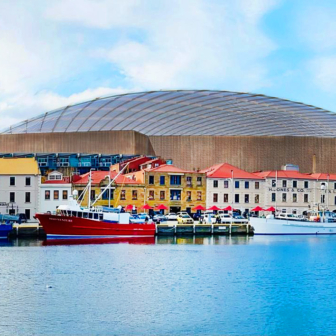IN Aleksei Popogrebsky’s film How I Ended This Summer, screening at Hobart’s State Cinema at the moment, the lone inhabitants of a remote Russian Arctic island – Sergei and Pavel – fall out. The problem starts smallish, with a fixable and forgivable failing of moral courage on Pavel’s part. Neither man fixes or forgives, however, and they become locked in mortal combat, driven by fear and suspicion to a kind of codependent madness. The ending – involving contaminated trout, and a final Slavic embrace – is bittersweet.
It’s a timely tale for Tasmania. As our own summer ends on our own remote island, are we poised to pick new fights or revive old feuds for the long, dark nights ahead?
There’s certainly cause for testiness. In recent years, Tasmania’s persistent socioeconomic cankers – its high rate of welfare dependence and poor educational retention rates – have been camouflaged by an unprecedented real estate boom, strategic pork-barrelling and the federal economic stimulus package. That feel-good factor flowed through much of David Bartlett’s premiership, which ran from May 2008 to January 2011. Bartlett issued a stream of announcements linked to the innovation strategy he’d commissioned from the University of Tasmania’s Australian Innovation Research Centre, most famously a food-bowl vision that’s back in the news now that the federal government has approved a massive irrigation scheme for the Midlands. More recently, the opening of gambler-philanthropist David Walsh’s Museum of Old and New Art has been a boon for boosterism – in just ten weeks, it’s attracted an estimated 130,000 visitors, promising new opportunities for Tasmania’s tourism industry.
But Tasmanians today are also staring down the multiple barrels of some very harsh realities. Utility bills are skyrocketing – and, with the recent privatisation of water and sewerage services, there are more of them. West Australian premier Colin Barnett’s recent jibe that Tasmania is a mendicant, anti-development state that’s become “Australia’s national park” – marginally more refined than his federal colleague Don Randall’s description of Tasmania as a “leech on the teat” of the national economy – has raised doubts about the security of Tasmania’s slice of the national GST pie. Fremantle could poach Tasmania’s Antarctic industry because of Hobart’s ageing port facilities, and the world-class Menzies Research Institute might lose staff and money in foreshadowed federal budget tightening. Tasmania’s Treasury is rumoured to be polishing very long knives for its own bone-deep cuts in the state’s June budget – over half of which is spent on public servants’ wages – and the early retirement incentive package just announced by the new premier, Lara Giddings, could be the thin end of a deep wedge. Speaking of wedges, a key challenge for Giddings is holding discipline in her own ranks – not so much within Labor’s dwindled parliamentary presence, but in her wider fowl-fish Labor–Green power-sharing government, which has been straining at a number of points, but has not yet fractured.
Last week’s news included the arrest of protesters at the site of the Brighton bypass, just north of Hobart. This federally funded project upgrades the Midlands Highway and involves construction of a dual-carriageway flyover at the Jordan River levee, a site named Kutalanya by Tasmanian Aboriginal groups. They oppose the project on the basis that sediment at the site contains up to three million artefacts dating back 42,000 years, making it the oldest known site of human habitation in the southern hemisphere. Both the precise heritage value of Kutalanya and the exact impact of the flyover are contested, and an alternative bridge location has been rejected as too costly by the state and federal governments. Commentator Sue Neales highlighted the irony of the premier and her heritage minister, Brian Wightman, celebrating the preservation of Tasmania’s convict heritage at the Cascades Female Factory on the same day police were dragging young Aboriginal leaders into paddy wagons at Kutalanya. In a related irony, Greens leader and Aboriginal affairs minister Nick McKim called for a halt to the project, evoking the “long-running shame” of the dispossession of the island’s Aboriginal peoples, while continuing to serve as a minister in the government that’s rolling it out.
That didn’t look good, and neither did the spectacle of Giddings being cornered into a public apology, in early April, alongside her children’s minister, Lin Thorp. The minister had imprudently revealed confidential information about the rankings in the selection process that had elected not to reappoint Paul Mason as Children’s Commissioner. Mason is now running as an independent against Thorp in the upcoming May poll for her upper house seat. Liberal opposition leader Will Hodgman unsuccessfully moved a no-confidence motion against Thorp for her “appalling, unethical and horrendous conduct.” Greens support for the motion would have brought down the government. After hours of backroom negotiations, against the backdrop of vocal Greens criticism of Thorp’s indiscretion, that support was not forthcoming.
The decision not to reappoint Mason was announced late last year, soon after he released a report criticising the behaviour of Thorp’s department in the case of a twelve-year-old Hobart girl who was sold for sex while she was a ward of the state. Of the approximately 120 men who were allegedly her paying clients, the criminal prosecution of just one is proceeding. That’s former Glenorchy mayor and state parliamentarian Terry Martin. Back when Paul Lennon was Tasmania’s premier, Martin was expelled from the parliamentary Labor Party in 2007 after crossing the floor to vote against legislation fast-tracking Gunns Ltd’s proposed pulp mill in the Tamar Valley. He has pleaded not guilty to the criminal charges.
Today Martin is muted in the public arena, and a book he was said to be writing about his experience of the pulp mill process is now unlikely to see the light of day. Speaking in late 2007, though, he was candid on that topic. The reaction to his crossing the floor on the pulp mill approval process, he said, “was like nothing I’ve ever seen before, and I’m not a novice. I was blown away by the response around Salamanca; it was basically hero worship.” At the same time, he was worried about the reaction in his electorate, whose heartland is the traditionally blue-collar, Labor suburb of Glenorchy. “I made the mistake of thinking Glenorchy people would probably be pro–pulp mill and buy the simplistic argument that it’s all about jobs,” Martin said, “So I came out here and purposely went for a walk round the CBD, Northgate, the bus station – the response was again extraordinary. In all these places there were people coming up to me… saying there’s something shonky, and we so admire you for standing up for your principles.”
Shonky days are here again, according to many rusted-on opponents of the pulp mill. Just when nearly everyone thought it was finally dead because of a lack of financing, the project has secured newly visible support from the Tasmanian government, now of course led by Giddings and her deputy, the “old Labor” pro-forestry stalwart Bryan Green. In March this year the pulp mill – wholly improved, insist its rusted-on supporters – emerged as the dealmaker or -breaker in the high-profile process of implementing the Tasmanian forestry statement of principles, signed by a range of environmentalists, industry groups and unions in October last year. Facilitated by former ACTU secretary Bill Kelty, the de facto bottom line in those negotiations became this – the price of an effective end to logging in Tasmania’s old-growth forests is supporting a plantation-fed pulp mill in the Tamar Valley.
THAT’s still like Sophie’s Choice for many Tasmanians. But which Tasmanians, and why do they feel that way?
The Kelty process has been criticised for its perceived lack of transparency, especially since green activist groups Still Wild Still Threatened and the Huon Valley Environment Centre walked away from negotiations at the start of April. Delivering his interim report at that juncture, Kelty acknowledged ongoing “cynicism and bitterness” in relation to the pulp mill approval process, called for an independent review of that process, and recommended compensation for Tamar Valley residents seriously affected by the mill. Since then, a coalition of influential pro-mill advocates has nailed its colours to the mast, coughing up $20,000 recently for a newspaper spread urging “the Tasmanian community and our leaders” to consider the pulp mill as “a necessary cornerstone investment which will underpin our state’s future prosperity.” Some 125 Tasmanian industry leaders (seven of whom were women) were named signatories, including senior executives of government business enterprises Forestry Tasmania, TasPorts and TasRail. All the webpages listed in the ad were government and Gunns Ltd websites. To many, that smartly wrapped package looked like a fish and smelled similar – but is that truly the case? Can Tasmanians trust that this product’s safe for consumption?
Given his fondness for vivid metaphor, you’d expect writer Richard Flanagan to have something to say about that. He’s long been one of the most outspoken opponents of the pulp mill. In early March, Flanagan stepped back into the fray, challenging the assurances of new Gunns Ltd managing director, Greg L’Estrange, who presents persuasively as the kinder, gentler face of the revived pulp mill. Reasserting his non-negotiable opposition to the project and his commitment to civil disobedience, Flanagan took another swipe at the “chainsaw Camorra” that allegedly runs Tasmania. “To agree to this mill is to say to everyone in Tasmania – every politician, every businessman, every citizen – that in the end might is right,” he wrote in the Mercury. “That the only law is the dollar, and that the corruption of our public life is not only acceptable but the only way to get anything done in Tasmania.” L’Estrange responded on the same pages: “I want to engage in a proper discussion and I fully understand that putting old enemies aside is very difficult. We can’t let that stand in the way. Holding on to these feuds is a luxury I can’t afford, nor can the rest of the Tasmanian community.”
As March wore on, their arm wrestle shifted to the ABC’s opinion website, the Drum. There, Flanagan attacked Kelty, saying he’d been duped by Gunns and dudded by the Tasmanian government. L’Estrange responded: “The challenge I send out to the likes of Richard Flanagan is: be objective not emotive and understand that yours is not the only point of view. They all matter, and we have a responsibility to find a way to meet many people’s needs, not just one. It is the mark of a civilised society.”
Surely that’s a key development challenge facing Tasmania today – how to build a society that’s more civilised and indeed civil. But can Tasmanians reach consensus on the best way to do that? Psychologist and parenting author Steve Biddulph – another strong opponent of the pulp mill – has called for restoration of due process at the point where it was broken, namely, in the fast-tracked legislative approval of the project in the Lennon era, Terry Martin’s political crucible. “While government remains too weak, or as some are arguing, too intellectually challenged to understand the need for strong laws, we will be vulnerable to third rate companies seeing Tasmania as easy pickings,” Biddulph wrote at the end of March. “Gunns may well disappear, but the problem will not be solved. Until we act like a first world jurisdiction, competent and businesslike investors will stay well clear.”
Since the last missive from L’Estrange, Flanagan has also made the case for civility. The occasion was the presentation of the 2011 Tasmania Book Prize for his novel Wanting (Random House, 2008) at a gala event in Hobart’s Town Hall on 3 April. The award was conferred by Giddings. Given that Flanagan was a key proponent of the international boycott of an earlier incarnation of this prize – because Forestry Tasmania sponsored part of the Ten Days on the Island festival in 2003 – she presumably approached the event with some trepidation. On the day, after Giddings gave her speech and handed over $25,000, Flanagan simply kissed her on the cheek and delivered a gracious speech in return. He did employ metaphor, and it was industrial: “Civility, so long absent in public life here, is not just a virtue, but a necessary practice if we are to grow together. Differences are the fuel of human change, civility the necessary oil that allows the motor to run.” Then Giddings and Flanagan hugged, and kissed again.
Dispensing much larger cheques the same week at the Sidney Myer Performing Arts Awards, this time in a spectacular space at the Museum of Old and New Art, the Sidney Myer Fund chairman Carrillo Gantner put the case against the pulp mill succinctly to invited dignitaries, parliamentarians and business people: “Art is more attractive than chlorine.” In that audience was social researcher Ross Honeywill, CEO of the Social Intelligence Lab and author of the bestselling book, NEO Power. Honeywill believes that Tasmania’s traditional economy should no longer frame debates about its future options. “We need a new, or neo, economy to future-proof jobs and investment in this state. And it will be delivered by cultural capital – creative, artistic, educational, intellectual, entrepreneurial, innovative, environmental assets,” reckons Honeywill, when I ask him about the pulp mill. Typically, he thinks, when politicians talk about economic development, they use Tasmania’s legacy industries as a reference point. “Discussion revolves around factory closures, forestry and pulp mills. But with manufacturing challenged and the timber industry in decline, the question must be asked… is the traditional economy enough in twenty-first-century Tasmania?”
“The economic power generated by cultural capital is beyond and distinct from the traditional industrial model of economic activity. It values and delivers economic value from tertiary assets. Creativity, innovation, knowledge, education and social equity have long been considered worthy but worthless, economically marginal, but they are now the new economic levers rather than the secondary assets of the industrial era (manufacturing, mining, industrial production),” expands Honeywill, getting to the guts of his “new economic order” theory. This is more than fanciful argument – he’s put his money where his mouth is, relocating with his artist wife Greer to Hobart last year. The opportunity for Tasmania today, reckons Honeywill, “is not in buttressing an industrial age legacy, but in creating a business culture of entrepreneurship and innovation – a neo-economy and the traditional economy coexisting peacefully. One is not better than the other – they’re just different.”
Just five to ten years ago in Tasmania, as many locals would attest from rough experience, you’d have paid a toxic price – professionally and personally – for saying much of that publicly. Which must amount to progress. •




